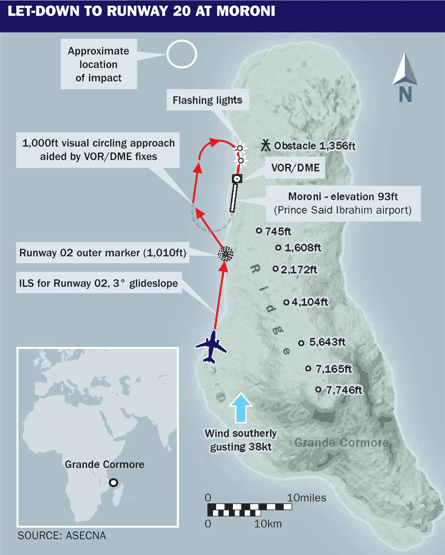The crew of the Yemenia Airbus A310-300 that crashed during a night let-down to Moroni airport on the Comoros Islands on 30 June faced a high-workload approach. Some airlines refuse to perform night approaches at the airport.There was no emergency call from the crew to indicate technical problems.
The aircraft crashed into the sea north-west of the island in a location least 20km (11nm) north of the flightpath that it would have been expected to fly to position for Runway 20.
All 11 crew and 141 of the 142 passengers were killed, but rescue boats picked up a 14-year-old girl survivor who, the Cormoros medical services report, received injuries, although she is expected to recover.
 |
|---|
The aircraft was a 19-year-old Pratt & Whitney PW4152-powered A310-300 (70-ADJ) leased by Yemenia from International Lease Finance.
According to Airbus, the accident took place at 01:50 on 30 June. Weather conditions indicate good night visibility, but there were strong southerly winds gusting to 38kt (70km/h).
At Moroni, where there are mountains to the south of the airport, those winds create turbulence and windshear in the airport’s vicinity. The pilots’ approach charts warn of windshear as a standard local hazard.
Moroni’s Prince Said Ibrahim airport is on the western coast of Grande Comore. It has a single north-south runway, 02/20, which is 2,900m (9,515ft) long.
At night, the aircraft, inbound from Sana’a, Yemen, would have been expected to carry out a VOR-DME-ILS (VOR-distance measuring equipment-instrument landing system) approach towards Runway 02 to stay clear of terrain in the non-radar environment, breaking left at the outer marker to position for a 1,000ft altitude right-hand visual circuit to land on Runway 20 because the wind that night would not have permitted a landing on Runway 02.
From the circuit’s downwind leg the aircraft has to carry out a curved descending right turn over the sea on to final approach, assisted by flashing lights under the flightpath intended to help the pilots avoid drifting inland where there is high terrain, so as to intercept straight-in finals about 4km from the runway threshhold.
Unconfirmed reports suggest the aircraft was lost during its second attempt at the approach.
See what David Learmount has to say on the matter on his blog Learmount: Safety and Politics don't mix
Source: Flight International























